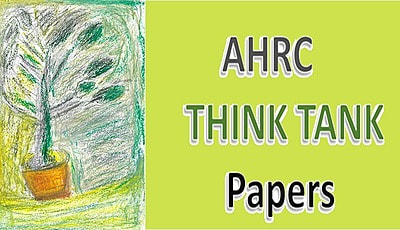Bangladeshi exclave dwellers are nobody’s headache
Dahagram and Angarpota are two villages within Indian territory, belonging to Bangladesh following a bilateral agreement signed in 1974 between the heads of the governments of Bangladesh and India. According to the agreement, which was signed on 16 May 1974, Bangladesh exchanged ‘enclaves’ with neighboring India. Bangladesh agreed to give away an area named Berubari of 2.64 square miles in exchange for ‘an area of 178 meters × 85 meters near ‘Tin Bigha’ to connect Dahagram with Panbari Mouza’, under the Patgram police station of the Lalmonirhat district.
After the agreement was signed by the two countries, separate legislative formalities were needed to approve the agreement in parliament. On 28 November 1974, the parliament of Bangladesh completed these so the agreement could be put into effect. The Indian parliament however, has not yet ratified the agreement, following a number of lawsuits and political debates.
A team from the Asian Human Rights Commission (AHRC) recently met with government representatives from the Dahagram Union Council and residents while visiting the area. The AHRC was told that the official population of the whole territory was 16,664 in a total land area of 22.68 square kilometers. However, the actual population, last counted in the 2001 census, shall be approximately 20,000 by the present time. There has been no electrification of the territory in over four decades, due to obstructions from the Indian authorities. An agreement between the two governments was made in January 2009 regarding the electrification of the territory by Bangladeshi authorities.
The territory is located in the Cooch Bihar district of West Bengal, India, with the Tista river on the west. It is otherwise surrounded by the areas of the Cooch Bihar district except for a gap of 500 meters or so, including the no-man’s lands between the mainland of Bangladesh and India. Some parts of the territory are fenced in along the border by the Indian authorities.
Movement, security and dignity
Mr Touhidul Islam, a community policeman of the Angarpota village, told the AHRC,
The state of Bangladesh only existed in the hearts of the people of this territory, as there was no direct assistance or facilities available from the public institutions. We had no opportunity to leave the place unless anyone could manage to get consent from the Indian border guards following repeated requests. It was also highly humiliating for us.
For instance, Touhidul noted that, “the Indian guards used to put identification marks on women’s blouses and petticoats whenever they allowed them to go out of the territory for medical treatment for a serious disease, and they were obliged to keep the marks and wear the same clothes when returning home”. Nobody should be sick at night however, Touhidul said, particularly after 9pm; the Border Security Force (BSF) guards at the gates of Tin Bigha simply dither for hours with innumerable excuses.
People normally seek help from the soldiers of the BDR (Bangladesh Rifles) whenever there is any serious patient like a woman with labor pains. Our soldiers request their Indian counterparts, who take time apparently to call the higher authorities, waste time, and finally say ‘no’! In most cases they claim that the relevant official was ‘unfortunately’ unreachable despite repeated attempts, and without that particular official the request cannot be entertained.
Mr Shamsuddin, a Dafadar (messenger) of the Dahagram Union Council describes daily life, where even buying groceries requires permission from the BSF. Residents had no choice but to comply and accept “the instructions and intimidation of the Indian forces, as there was nobody from the Bangladeshi authorities to protect us in such a vulnerable condition. We are surrounded by Indians.” Even demanding facilities from the Bangladeshi authorities resulted in regular repression by the BSF and Indian police, Shamsuddin noted. He continued,
Our people were seriously beaten by Indian soldiers after the visit of President General Ershad, who came here in the 1980s to see our situation, and with whom we shared our problems.
The confinement continued until 26 June 1992, when people got their first opportunity to go to the mainland of Bangladesh crossing the Tin Bigha. That’s the day when the Indian government implemented one of its agreements to open the gate at the Tin Bigha corridor for only 12 hours a day in two slots of three hours each. We felt that we were liberated!
According to another community policeman, Mr Hafizur Rahman, “The people of Dahagram and Angarpota did not have even a minimum freedom of movement, allowing them to go from the territory to the mainland of Bangladesh.” While the territory may officially be termed an ‘enclave’1 , it remains an ‘exclave’2 in terms of people’s “dignity and security; we still do not have our sovereignty here”. Explaining the situation, Hafizur said,
Earlier, the Indian authorities did not allow the Bangladesh Police to enter into this place. Now, the police can come without any arms. They can only carry sticks. We have a police camp comprising 16 personnel including one Sub Inspector and an Assistant Sub Inspector. The Bangladesh Army is not allowed to come here. For the first time in history, an army team came to Dahagram having special permission from the Indian government during the general election on 29 December 2009.
Medical assistance and natural calamities
There is only one public hospital in the territory, with an official number of 10 beds, and a reported staff of 12, including two doctors. In reality however, there has been no qualified doctor to treat the patients.
The AHRC team met Mr Jillur Rahman at the hospital, who is a staff member there, with a Diploma of Medical Faculty (DMF). He is a new recruit, and says, “At this stage I have no alternative but staying here. Most staff do not prefer staying inside the Dahagram area due to the lifestyle, which seems confined.” This is because there are only 12 hours to get to the mainland and return home again.
If there is any delay due to transportation or any unexpected inconveniences at arriving at the gate of the Tin Bigha corridor, which is fully controlled by the BSF, the person can only return home on the following morning after the gate opens again. This condition of confinement causes a lot of problems to the people.
Jillur was checking a patient’s pulse and injecting a vaccine for which he received money from the patient, while talking to the AHRC. He said the Dahagram hospital barely receives any supply of medicine from the government. As a result, patients have to buy medicine from the mainland, which incurs extra transportation costs as well as other hazards of travelling. So, whenever Jillur visits the mainland he buys common medicines to help the patients.
Apart from suffering at the hand of political and bureaucratic idiosyncrasies, villagers also have to endure natural catastrophes due to the erosion of the Tista river. The erosion destroys households along the eastern bank of the river, increasing the number of homeless families. In order to control the erosion, the government constructed a dam on the eastern side of the river. However, inhabitants of the eastern bank allege that the relevant company and officials were mired in corruption, resulting in a poorly made dam. Therefore, the erosion continues and new houses are destroyed every year, deepening people’s sorrows. Nobody knows whether the river will take away their home or not. The people can do nothing but blame their own fate.
———-
1 An enclave is a territory whose boundaries lie entirely within another territory.
2 An exclave is a territory legally attached to another territory with which it is not physically contiguous.



